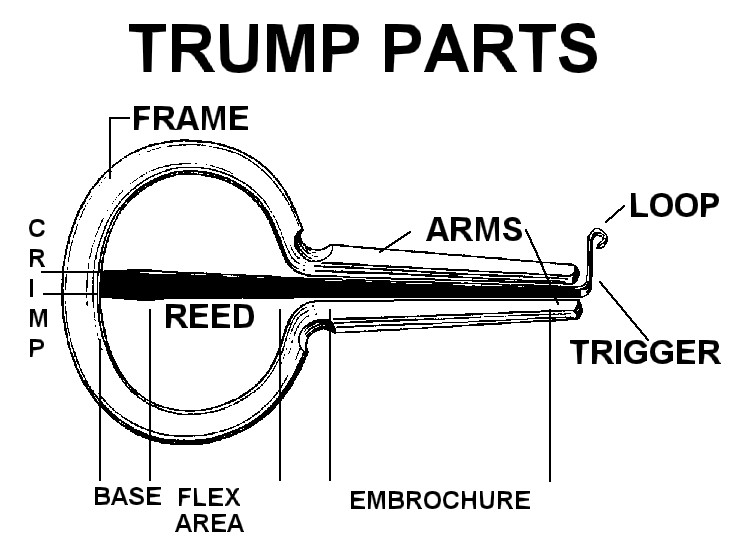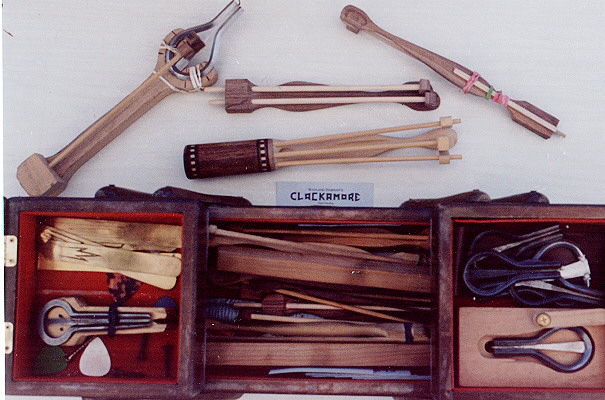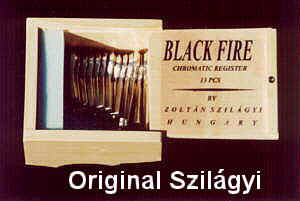Tips & Tricks
Selecting a Trump
Mouth Music offers a variety of trumps. To
the first-time trump buyer the selection can be confusing. Even the more experienced
trumpist, who's not familiar with the instruments offered here, may find selecting
one that's right a challenge.
Here are a few tips:
Ask yourself the following questions:
- Am I an experienced trumpist or new to the instrument?
Some trumps are more difficult for the beginner to play than others. Usually the
frame/tongue spacing is smaller on higher quality instruments and the beginner may have
trouble plucking without the tongue striking the frame. If you are new to the instrument,
we might suggest you start off with a Kubing
or Cambodian bamboo harp,
which is held against the lips rather than the teeth. By playing the Kubing, you'll learn
the basics of breath and pitch control, and develop a feel for plucking.
A good next step may be to move up to an inexpensive steel-trump such as our
Chancellor. This untuned trump has a full
steel-trump sound but its frame/tongue spacing is still loose enough not to discourage the
new player. With practice, you'll eventually learn to pluck straight-and-true, and enhance
your breath control skills. Once you've mastered these basic techniques you'll be ready to
move up to higher quality instruments and the joys they bring. The only disadvantage to the Chancellor is the the trigger is a small bend or ball rather than a loop
For an inexpensive tuned trump, I usually suggest the Hörzing Coal Black. It has a looped trigger and is fairly easy to play. However the higher the pitch, the smaller the trump, which may discourge some beginners... but the smaller size may suit folks with smaller hands.

What types of music do I generally play? What are the most
common keys used?
- Do I generally play with other instruments? If so, what
kinds, and what are the most common keys they use?
These two questions have a similar response and require a basic
knowledge of music. If you're unsure what the common keys are for the type of music or
instruments, ask your playing partners and select the key or keys they point out. We might
suggest the keys of 'C', 'D' or 'G' as a starting point for use with many
"western" types of music or instruments (such as guitar).
- What other trumps do I have in my collection?
What keys? What keys do I need?
What different sounds do I need?
Unlike many other musicians that can play in a variety of keys on the same
instrument, the Trumpist often must select a different instrument to play in a new key. As
a result, many Trumpists carry a "kit" which contains a variety of trumps in
different keys. These kits are sometimes quite elaborate and represent the players' entire
collection. Other times you'll see "gig kits" that hold only select trumps
for the situation.

Wayland's old "Trump Kit"
- of course he carries a lot of Clackamores too!
Every type of trump has different qualities and characteristics:
tuned or untuned; harsh or sweet; loud or not-so-loud; lots of overtones, or fewer, more
prominent overtones. Consider the type of sound you want and look for trumps that fit
the bill. For example, if you like to play bass lines along with a guitarist, a low 'A' Szilágyi Black Fire
may be perfect. If you play traditional European folk songs, a high 'A' Hörzing is a good choice. For
"Country, Western or Bluegrass" music a Whitlow
in 'D' or 'G' may work well. Two trumps an octave apart is also a good idea.
Not all Trumpists favor common "styles" of
music but prefer instead to concentrate on more esoteric qualities of the sound. Maybe a
harsh dissonant highlight is just what they want to hear... or perhaps a low meditative
rumble. Whatever the situation, having a selection of trumps makes it more likely to find
the "right tool for the job."
- Do I play with other trumpists? If so,
What keys and types do they have?
What trumps and keys work with theirs?
Do you want to try to play chords together?
When several Trumpist get together, anything is likely to happen.
You'll see them digging through each other's kits with near "Christmas morning"
excitement and trying all sorts of combinations... "my low untuned Siberian works
with your old Morsing..." If you play with the same group often, it's a good
idea to keep a small notebook in your kits and log the successful combinations for future
reference. You may even want to acquire a new trump that you think will work well with one
of theirs.
A group of Trumpist can explore the opportunity of creating
"trump chords." Select a number of trumps in keys that make up a chord
(i.e. high or low 'C', 'E' & 'G') and try playing them together... or one at a time on
different beats. Same model trumps work great but peculiar combinations may yield
startling results.

- Do I need a set of Trumps?
Having a entire set of trumps of the same maker and model has certain advantages. It is
not uncommon in Europe for a Trumpist to hold and play several trumps at (nearly) the same
time. Since the same model is used, changing from trump to trump alters only the key, not
other characteristics.
Most makers offer sets of trumps. Chromatic sets usually include a low
fundamental, a high fundamental, and all the half steps in between... totaling 13 trumps. Diatonic
sets don't contain any sharps or flats and total 8 trumps. Buying a set can also
save you money as a set price is usually less than sum of individual trumps bought
separately.
|





